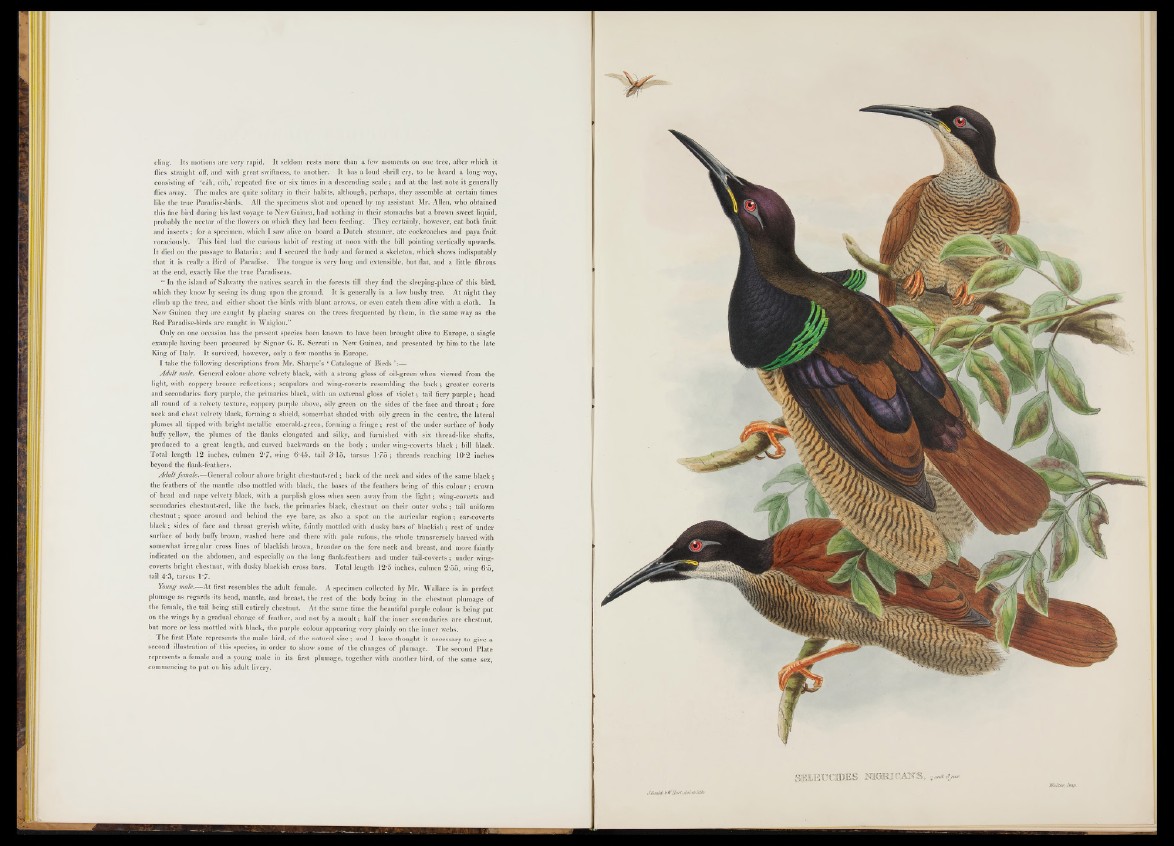
cling. Its motions are very rapid. It seldom rests more than a few moments on one tree, after which it
flies straight off, and with great swiftness, to another. It has a loud shrill cry, to be heard a long way,
consisting o f ‘cah, cah,’ repeated five or six times in a descending sca le; and at the last note it generally
flies away. The males are quite solitary in their habits, although, perhaps, they assemble at certain times
like the true Paradise-birds. AH the specimens shot and opened by my assistant Mr. Allen, who obtained
this fine bird during his last voyage to New Guinea, had nothing in their stomachs but a brown sweet liquid,
probably the nectar of the flowers on which they had been feeding. They certainly, however, eat both fruit
and insects ; for a specimen, which I saw alive on board a Dutch steamer, ate cockroaches and paya fruit
voraciously. This bird had the curious habit o f resting at noon with the bill pointing vertically upwards.
It died on the passage to Batavia; and I secured the body and formed a skeleton, which shows indisputably
that it is really a Bird of Paradise. The tongue is very long and extensible, but flat, and a little fibrous
at the end, exactly like the true Paradiseas.
“ In the island o f Salwatty the natives search in the forests till they find the sleeping-place o f this bird,
which they know by seeing its dung upon the ground. It is generally in a low bushy tree. At night they
climb up the tree, and either shoot the birds with blunt arrows, or even catch them alive with a cloth. In
New Guinea they are caught by placing snares on the trees frequented by them, in the same way as the
Red Paradise-birds are caught in Waigiou.”
Only on one occasion has the present species been known to have been brought alive to Europe, a single
example having been procured by Signor G. E. Serruti m New Guinea, and presented by him to the late
King o f Italy. It survived, however, only a few months in Europe.
I take the following descriptions from Mr. Sharpe’s ‘ Catalogue o f Birds ’:—
Adult male. General colour above velvety black, with a strong gloss o f oil-green when viewed from the
light, with coppery bronze reflections; scapulars and wing-coverts resembling the back; greater coverts
and secondaries fiery purple, the primaries black, with an external gloss o f violet; tail fiery purple; head
all round o f a velvety texture, coppery purple above, oily green on the sides o f the face and throat; fore
neck and chest velvety black, forming a shield, somewhat shaded with oily green in the centre, the lateral
plumes all tipped with bright metallic emerald-green, forming a fringe ; rest o f the under surface o f body
buffy yellow, the plumes o f the flanks elongated and silky, and furnished with six thread-like shafts,
produced to a great length, and curved backwards on the body; under wing-coverts black ; hill black.
Total length 12 iuches, culmen 2*7, wing 6*45, tail 3*15, tarsus 1*75; threads reaching 10*2 inches
beyond the flank-feathers.
Adult female.— General colour above bright chestnut-red; back o f the neck and sides o f the same black;
the feathers o f the mantle alsp mottled with black, the bases o f the feathers being o f this colour; crown
o f head and nape velvety black, with a purplish gloss when seen away from the lig h t; wing-coverts and
secondaries chestnut-red, like the back, the primaries black, chestnut on their outer webs; tail uniform
chestnut; space around and behind the eye bare, as also a spot on the auricular region; ear-coverts
black; sides of face and throat greyish white, faintly mottled with dusky bars o f blackish; rest of under
surface o f body buffy brown, washed here and there with pale rufous, the whole transversely barred with
somewhat irregular cross lines of blackish brown, broader on the fore neck and breast, and more faintly
indicated on the abdomen, and especially on the long flank-feathers and under tail-coverts; under wing-
coverts bright chestnut, with dusky blackish cross bars. Total length 12*5 inches, culmen 2*55, wing 6*5,
tail 4*3, tarsus 1*7.
Young male.— At first resembles the adult female. A specimen collected by Mr. Wallace is in perfect
plumage as regards its head, mantle, and breast, the rest o f the body being in the. chestnut plumage of
the female, the tail being still entirely chestnut. At the same time the beautiful purple colour is being put
on the wings by a gradual change o f feather, and not by a moult; half the inner secondaries are chestnut,
but more or less mottled with black, the purple colour appearing very plainly on the inner webs.
The first Plate represents the male bird, o f the natural siz e ; and I have thought it necessary to give a
second illustration o f this species, in order to show some o f the changes o f plumage. The second Plate
represents a female and a young male in its first plumage, together with another bird, o f the same sex,
commencing to put on his adult livery.
Walter, Imp.
SELEUCIDES NIGRICANS,
JGtmlct IrWBiat', deteaUth/.